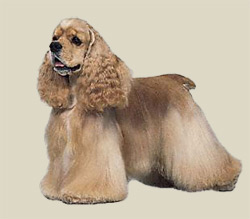
Country of Origin: United States
Group: Retrievers - Flushing Dogs - Water Dogs
Section: Flushing Dogs
Original Function: bird flushing and retrieving
Todays Function: spaniel field trials
Dimension Male: 38 cm
Dimension Female: 36 cm
Weight Male: 11-13 kg
Weight Female: 11-13 kg
Litter Size: 1-7 puppies, average 5
Life span: 12-15 years
Other Names: Cocker Spaniel
Colors: Black and tan, black, any solid color other than black ascob,, parti-colored white and any other sol
Living: The cocker spaniel is a very adaptable dog that can do well in a smaller space such as an apartment
Recognized: FCI, AKC, UKC, KCGB, CKC, ANKC, NKC, NZKC, CKC, CCR, APRI, ACR
Description
The Cocker Spaniel has very long hanging ears, a rounded head, and a profuse, silky, feathered, medium-length coat. The head is chiseled with an abrupt stop. The muzzle is wide, deep and broad with a square jaw. The upper lip hangs down, covering the lower jaw completely. The teeth are strong and should meet in a scissors bite. The nose is always black on black dogs, but may be brown on other dogs. The eyes are round, set on so they look straightforward. The eye rims are slightly oval. Merle Cocker Spaniels can have blue eyes. The body is compact, with a short back. The topline should slope gently downwards from front to back. The front legs are straight, with good bone. Dewclaws on front and rear legs should be removed. The coat comes in buff, black, and other solid colors, merle, black-and-tan like a Rottweiler or Doberman Pinscher,, parti-color white with black, white with buff or red, white with black and tan points, Some requirements for correct markings are specified in the standard. The tail is docked to 2/5 it"s original length and is carried on a line with its back; it is constantly in motion. Field lines generally have shorter coats which are better suited to work in brush. They also have better hunting instincts. Both types make good pets.
Temperament
This breed is known as the "merry" cocker, and the name is most fitting. It is playful, cheerful, amiable, sweet, sensitive, willing to please and responsive to its family"s wishes. It is not known for retaining its hunting instincts, but it is inquisitive and will appreciate a country outing. It is equally at home in the city and will happily walk on leash for its exercise needs. Some bark a lot; some are overly submissive.
Excercise
Although it enjoys a romp, the cocker can receive adequate exercise with a long daily walk on leash. The coat of the cocker requires a greater commitment than that of most breeds, although pets can be clipped short. In order to maintain a nice coat, it will need to be brushed and combed two to three times a week, in addition to professional clipping and scissoring every two to three months. Special attention must be paid to ear and eye cleanliness in this breed. The profusely coated feet tend to carry debris. The cocker is physically able to live outside in temperate climates given adequate shelter,, but it is not mentally able to do so; this is such a social dog that to banish it outdoors would not be acceptable. cockers have a tendency to become overweight.
Grooming
The eyes need regular cleaning. Some owners prefer to leave the coat long, brushing daily and shampooing frequently with quarterly scissoring and clipping. Others prefer to clip the coat to medium length to be more functional. Either way, the dog will nee
Health
Major concerns: cataracts, glaucoma, patellar luxation
Minor concerns: CHD, ectropion, entropion, PRA, allergies, seborrhea, lip fold pyoderma, otitis externa, liver disease, urolithiasis, prolapse of nictitans gland, CHF, phosphofructokinase deficiency, cardiomyopathy
Occasionally seen: gastric torsion, elbow dysplasia
Suggested tests: eye, knee, DNA for phosphofructokinase deficiency, hip,

